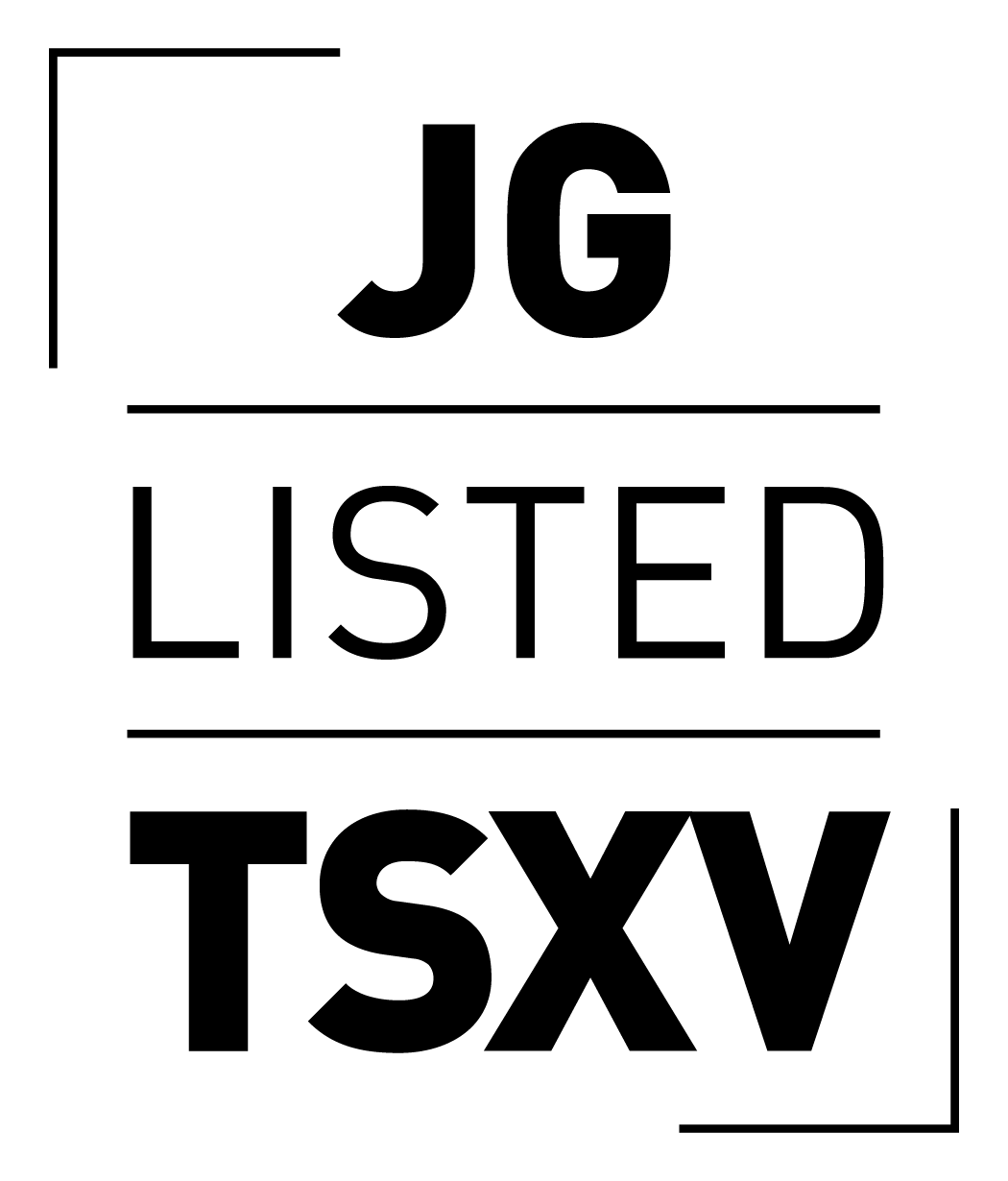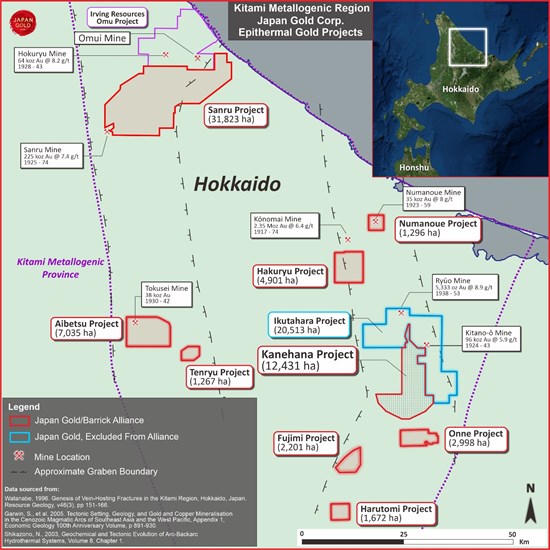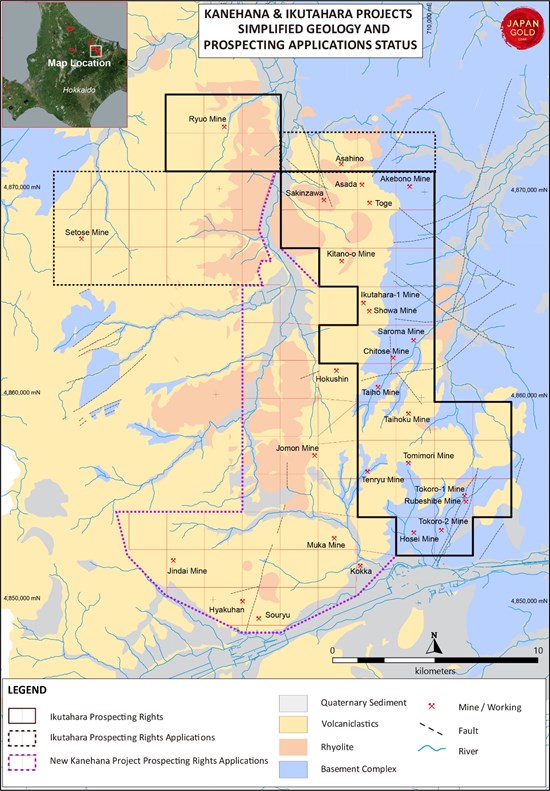Vancouver, British Columbia--(Newsfile Corp. - September 23, 2020) - Japan Gold Corp. (TSXV: JG) (OTCQB: JGLDF) (the "Company") is pleased to announce acquisition of the Kanehana Project via the acceptance of 40 new prospecting rights applications by the Japanese Ministry of Economy, Trade and Industry ("METI"). The new 12,431 hectare project adjoins the west side of Japan Gold's Ikutahara Project and covers seven historic gold mines and workings.
Highlights:
- The Kitami Metallogenic Province of northeast Hokkaido is host to numerous historic gold mines, including the Konomai Mine, Japan's third largest gold mine (2.35Moz @ 6.4g/t gold)
- The 40 new applications cover 7 historic gold mines and workings with limited development and production prior to 1942, locally high-grades reported in these mines indicate further investigation is warranted
The Kanehana Project
Located on the west side of the Ikutahara Project, the Kanehana Project covers favorable Miocene-age rhyolite and associated graben-fill volcanics and sediments. The Kanehana and Ikutahara Projects combined, cover a 25-kilometer strike-zone along the eastern edge of the Monbetsu-Rubeshibe Graben where the intersection of deep-seated graben-margin and cross-cutting faults provide the pathways for ascending gold-bearing hydrothermal fluids. The majority of mines and workings within the projects, occur close to these structural intersections, seven within Kanehana and twenty within Ikutahara. These mines include the Region's third largest gold producer, the Kitano-o Mine where in excess of 96,000 ounces of gold at a grade of 5.9 g/t1 were mined at Kitano-o prior to 1943, gold was won largely from shallow open-pits in gold-bearing eluvium.
Included within the Kanehana Project are the historic, Muka, Jindai, Jomon, Hokushin, Kokka, Hyakuhan and Souryu gold mines and workings (Figure 2).
Muka Mine
Small scale exploitation at the Muka Mine was conducted by Sumitomo Metal Mining Co. Ltd between 1939-42 with 12,473 tonnes of ore mined at an average grade of 7.09g/t Au and 20.8 g/t Ag2. Two types of mineralization are described at Muka; a quartz vein event with more than ten north-south and east-west oriented veins, with dimensions between 0.2 to 1.0 meters wide and up to 100m in strike length; and a network-breccia like body formed around the veins with lateral dimensions of 80 by 40 meters and up to 130 meters vertical extent2. It is reported that the highest grades occur at vein intersections with grades up to 500g/t gold and 2,000g/t silver; the breccia is also gold bearing and described as having a clay matrix hosting silicified fragments; surficial-elluvial gold mineralization is also reported2. It is unclear based on the historic description what the chronology of mineralizing events are but the presence of superimposed gold bearing vein and breccia events is a strong vector for deeper exploration.
Jindai Mine
Underground mining between 1938-42 focussed on narrow (0.5-1.0 m width) gold-bearing epithermal quartz veins and veinlets. Small-scale exploitation reported average grades of 11.8 g/t gold and 90.8 g/t silver in the rhyolite hosted veins.
Exploration completed after the second world war reports shallow tunneling on so-called residual elluvial workings and up to 50 shallow drill holes which intersected two major veins. Based on this work it was reported that a full-scale exploration program was proposed for the deeper levels but no additional information is available on this work as it may not have been funded.
Jomon Mine
Information on mining is limited but sampling of numerous quartz boulders in the small open pit report grades averaging 25 g/t gold and 50 g/t silver2. In 1933 an underground cross-cut was excavated to locate the source of the high-grade boulders but results are unknown.
The Hokushin, Kokka, Hyakuhan and Souryu workings published on the 1:50,000 Japanese Geological Survey maps show these as gold-silver occurrences, but limited data on the workings has been sourced by the Company to date.
The Kitami Metallogenic Province
The Kitami Metallogenic Province of Northern Hokkaido is characterized by rhyolite geology associated with epithermal-gold mineralization, localized along two major north-south trending grabens. Numerous gold mines hosted within these two grabens were developed in the region up to 1943 including the Konomai Mine, Japan's third largest gold mine, which produced 2.35 million ounces of gold at an average grade of 6.4 g/t and 40 million ounces of silver prior to closure in 1974, the Kanehana Project is located 25 kilometers south of the Konomai Mine, Figure 1.
References
1Garwin, Hall, Watanabe, (2005). Tectonic Setting, Geology, and Gold and Copper Mineralization in Cenozoic Magmatic Arcs of Southeast Asia and the West Pacific. Economic Geology 100th Anniversary Volume, pp. 891-930.
2Gold Mines of Japan, 1989. The Mining & Materials Processing Institute of Japan.
Qualified Person
The technical information in this news release has been reviewed and approved by Japan Gold's Vice President of Exploration, Andrew Rowe, BAppSc, FAusIMM, FSEG, who is a Qualified Person as defined by National Instrument 43-101.
On behalf of the Board of Japan Gold Corp.
"John Proust"
Chairman & CEO
About Japan Gold Corp.
Japan Gold Corp. is a Canadian mineral exploration company focused solely on gold exploration across the three largest islands of Japan: Hokkaido, Honshu, and Kyushu. The Company has a country-wide alliance with Barrick Gold Corporation to jointly explore, develop and mine certain gold mineral properties and mining projects. The Company holds a portfolio of 31 gold projects which cover areas with known gold occurrences, a history of mining and are prospective for high-grade epithermal gold mineralization. Japan Gold's leadership team represent decades of resource industry and business experience, and the Company has recruited geologists, drillers and technical advisors with experience exploring and operating in Japan. More information is available at www.japangold.com or by email at
For further information, please contact:
John Proust
Chairman & CEO
Phone: 778-725-1491
Email:
Cautionary Note
Neither the TSX Venture Exchange nor its Regulation Services Provider (as such term is defined in the policies of the TSX Venture Exchange) accepts responsibility for the adequacy or accuracy of this release. This news release contains forward-looking statements relating to expected or anticipated future events and anticipated results related to future partnerships and the Company's 2020 gold exploration program. These statements are forward-looking in nature and, as a result, are subject to certain risks and uncertainties that include, but are not limited to, general economic, market and business conditions; competition for qualified staff; the regulatory process and actions; technical issues; new legislation; potential delays or changes in plans; working in a new political jurisdiction; results of exploration; the timing and granting of prospecting rights; the Company's ability to execute and implement future plans, arrange or conclude a joint-venture or partnership; and the occurrence of unexpected events. Actual results achieved may differ from the information provided herein and, consequently, readers are advised not to place undue reliance on forward-looking information. The forward-looking information contained herein speaks only as of the date of this News Release. The Company disclaims any intention or obligation to update or revise forward‐looking information or to explain any material difference between such and subsequent actual events, except as required by applicable laws.
Figure 1: Kitami Metallogenic Province, Omu-Kamikawa and Monbetsu-Rubeshibe Grabens and Japan Gold and Barrick Alliance project portfolio.
To view an enhanced version of Figure 1, please visit:
https://japangold.com/images/news_releases/2020/Japangold-News-sep-23-01-2.jpg
Figure 2: Ikutahara Project, simplified geology, prospecting applications status and historic mines and workings.
To view an enhanced version of Figure 2, please visit:
https://japangold.com/images/news_releases/2020/Japangold-News-sep-23-02-Full.jpg

To view the source version of this press release, please visit https://www.newsfilecorp.com/release/64455




